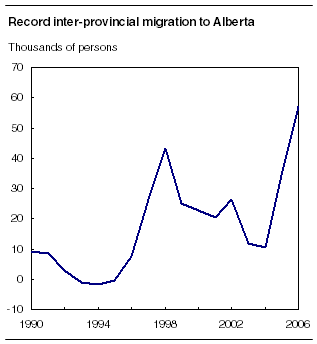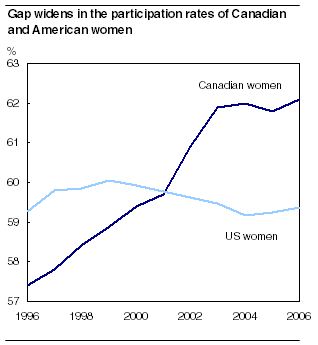Common menu bar links
Study: Year end review of the economy
Archived Content
Information identified as archived is provided for reference, research or recordkeeping purposes. It is not subject to the Government of Canada Web Standards and has not been altered or updated since it was archived. Please "contact us" to request a format other than those available.

In retrospect, the most surprising development in Canada's economy last year was not that a surge in oil prices or the bursting of the American housing bubble failed to dampen growth, according to a year-end review of the economy.
Instead, the surprise was that so many people continued to underestimate the ability of Canadians to react and adapt to fast-changing or unexpected circumstances, the review suggests.
The theme that really stands out is the adaptability of Canadians faced with rapid changes in their economy, it concludes. The most dramatic example of this was the increased migration of people to oil-rich Alberta during the past year.
The study, published today in the online edition of Canadian Economic Observer, concludes that Alberta's dominant role in economic growth was the biggest economic story of the year.
Going back several years, the economy has been hit with a number of shocks which in the past could well have triggered a slowdown or even recession. Instead, growth has been remarkably stable since 2003.
Real gross domestic product expanded 2.7%, only marginally less than the 2.9% gain in 2005, despite a mid-year slowdown. This rate of growth was exactly the same as the average annual gain since 2003.
The mildness of the slowdown in growth was even more surprising in light of concerns and perceived threats expressed about the economy, including the slump in the automobile and housing markets.
That the perceived threats to growth did not derail the economy is not new. Just in the past decade, the economy has survived shocks ranging from the Long-Term Capital Management collapse to the Asian and Russian financial crisis in the late 1990s, the review noted.
The economy also survived the bursting of the high-tech bubble (which triggered the worst bear market for stocks since the Great Depression); the 9/11 terrorist attacks and persistent turmoil in the Middle East; and the jump in the exchange rate and commodity prices.
The resource boom
The current boom in commodity prices is now entering its fifth year. Initially, it was sparked by a surge in the energy sector. Metals took the lead in pushing up prices to record levels last year.
So-called "blue-collar" metals such as copper, nickel, zinc and iron ore spearheaded the advance, overshadowing their more illustrious precious metal cousins, such as silver and gold. This reflects higher demand in the rapidly expanding industrial base of developing countries, notably China. One measure of the strength of mining was that it was the only industry that increased employment in every province last year.
The development of the oil sands in northern Alberta remained the dominant trend in the energy sector, reshaping Canada's economic geography. Firms continued to pour money into these investments, tripling from $5.2 billion when the current surge in oil prices began in 2003 to a planned $16.1 billion in 2007.
The economic impact of the development of the oil sands rippled across Alberta, which had a litany of record-setting performances. They include fastest increase ever in retail sales (+16.2%), biggest hike in building permits and in non-residential construction ($3.6 billion and $1.1 billion respectively), the lowest unemployment rate (3.4%) and largest net inter-provincial migration on record.
The number of unemployed in Alberta (66,800), was the lowest in absolute terms since 1981, despite population growth of nearly one million (+47%) in the past quarter century. Its 4.8% increase in employment was the most of any province in nearly a decade.
Alberta by itself accounted for the faster gain in employment and retail sales in Canada than in the United States. In fact, without Alberta, growth in the rest of Canada lagged slightly behind the United States on both accounts.
Great trek westward
Alberta proved to be an increasingly attractive destination for people from all provinces. It received a net inflow of 57,105 people from other provinces, the largest inter-provincial movement of people to one province on record back to 1972.
The trek west accelerated sharply over the last two years, as word of the Alberta boom spread: after an average net inflow of just 11,000 people in 2003 and 2004, inter-provincial migration accelerated to 34,423 in 2005 before its record-setting performance last year. In the last decade, the net inflow of 285,620 inter-provincial migrants was the equivalent of 10% of Alberta's overall population in 1996, and nearly half of its growth of 600,600 people.

In any other year, British Columbia would have been the provincial success story. Employment in British Columbia grew 3.1% in 2006, on the heels of a 3.3% gain in 2005. This matched Alberta's torrid growth over the last two years. By early 2007, unemployment in British Columbia had fallen below 4.0%, a level that only Alberta and Saskatchewan have successfully broken through. Job growth was again led by mining.
Labour market: Unrelenting impact of the boomers
Canada's demographic profile shows the unrelenting impact of the aging of the boomer generation. The share of the prime-aged labour force (25 to 54) dropped below 70% for the first time in nearly two decades as the first boomers turned 60.
Labour force growth was sustained by ongoing gains in the participation rates of women. After a brief pause in growth in 2005, a record 62.1% of all women were in the labour force last year. Since 1999, their participation rate has risen 3.2 points, more than in all of the 1990s.
One reason women continued to enter the labour force was their increasing prospect of getting a job. Unemployment among adult women was a record low of 5.2% last year, and has been below that of adult men every year since 2000. (Historically, it fell below men only during recessions).
The increasing attachment of Canadian women to the labour force was in marked contrast with the United States. There, the participation rate of women peaked at 60% in 1999, before falling steadily to 59.4%.

This growth was a critical development in a labour market increasingly characterized by aging and shortages. Given the widening gap in educational attainment between women and men, this also assured a growing supply of the most skilled workers. In 2006, the number of women with a university degree exceeded men for the first time ever.
Another difference with the United States was the recovery in youth employment rates in Canada. Last year, 58.7% of youths aged 15 to 24 held a job, up from a low of 51.5% a decade ago. The increase was equally evident for teens and older youths.
In contrast, youths (especially teens) have been withdrawing from the labour force in the United States as their unemployment rate rose. The increase in Canadian youths holding jobs relative to American youths was equivalent to 1.5% of total employment.
Consumers were unfazed by rising gas prices
Consumer spending continued to expand briskly last year, underpinned by strong labour, housing and stock markets.
Not even record high energy prices deterred consumers. While prices rose another 5% on average, the mild winter weather lowered the use of energy for home heating enough that consumers actually devoted a smaller share of their budgets to energy than in 2005.
Consumers in Canada mostly shrugged off the effect of rising gasoline prices on their driving habits, never mind their overall behaviour.
Retail gasoline consumption has continued to increase every year since 2002, including a 0.8% rise last year. The only concession drivers made to higher prices was to switch from premium to regular grade gasoline in each year.
Neither did rising gasoline prices broadly affect the level or composition of vehicle sales. Overall, unit sales were the second highest ever, just 4% below the record set in 2002.
For the fifth straight year, purchases of trucks rose faster than car sales. In fact, the strength of truck sales pushed the share of cars in all vehicle sales to a record low of 51.7% last year.
The study "Year end review" is now available for free online. The study is also included in the April 2007, Internet edition of Canadian Economic Observer, Volume 20, no. 4 (11-010-XWB, free), which is now available. The monthly paper version of Canadian Economic Observer, Volume 20, no. 4 (11-010-XPB, $25/$243) will be available on April 19.
From the Publications module of our website, click on the banner ad for Canadian Economic Observer.
For more information, or to enquire about the concepts, methods or data quality of this release, contact Philip Cross (613-951-9162; ceo@statcan.gc.ca), Current Economic Analysis Group.

